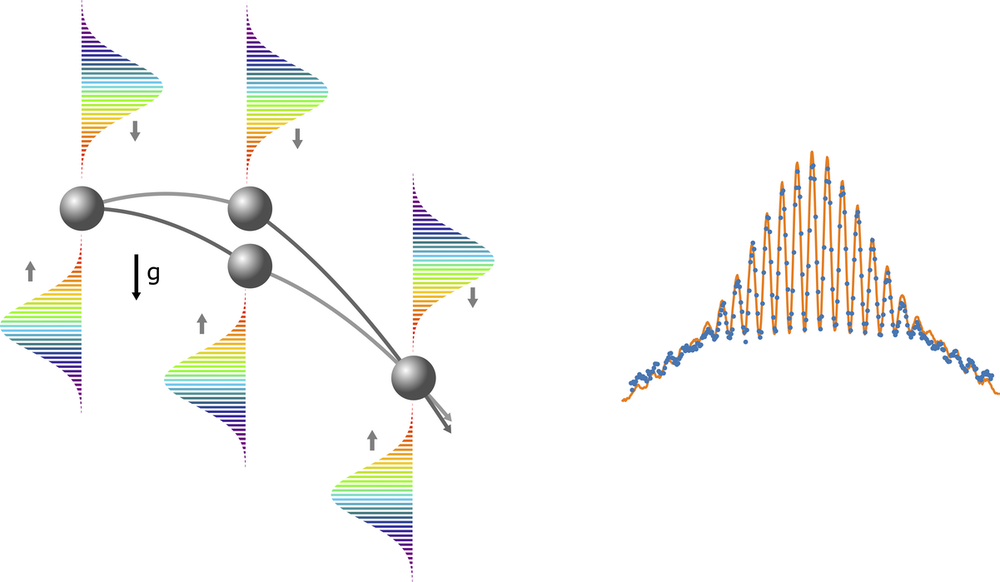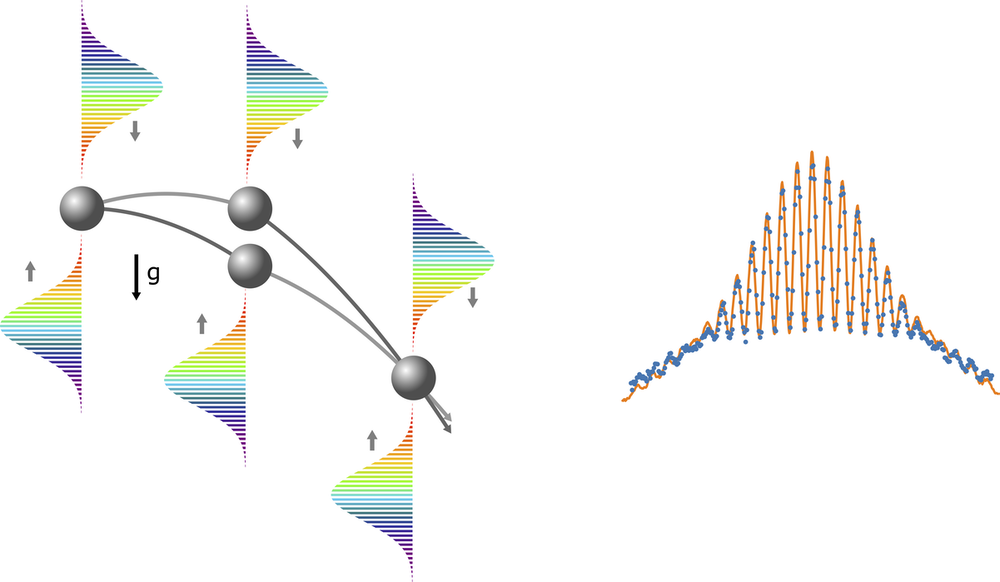Frequency Comb Measures Quantum Interference
In atom interferometry, researchers use the interference of quantum waves of matter, often for high-precision experiments testing fundamental physics principles. A research team has now demonstrated a new way to produce matter-wave interference by using a frequency-comb laser—a comb-like set of spectral lines at regularly spaced frequencies [1]. The comb allowed the team to generate interference in a cloud of cold atoms. The method might ultimately be used to investigate differences between matter and antimatter.
According to the weak equivalence principle, gravity must cause both matter and antimatter to fall at the same rate (see the graphical explanation, The Equivalence Principle under a MICROSCOPE). Deviations from this principle could point to explanations for the hitherto mysterious imbalance in the amounts of matter and antimatter in the Universe. Atom interferometry could provide a test of weak equivalence through precise measurements of the free fall of antihydrogen. So far, light-based control of atom interferometry has used continuous-wave (cw) lasers [2], which can’t easily be extended to the short wavelengths in the extreme ultraviolet (XUV) that are needed for such studies of antihydrogen.
Frequency combs offer a way around that obstacle because they can potentially produce precisely tuned XUV light. They are typically produced by a train of ultrashort laser pulses that provides a spectrum of equally spaced laser frequencies (spectral lines) all at once. Cyrille Solaro of Sorbonne University in Paris and his co-workers have now shown that a frequency comb can be used to generate interference within a cloud of free-falling cold rubidium atoms.
In the experiment, the frequency comb creates a quantum superposition, meaning that the atoms occupy two different states simultaneously. The comb prepares each state as a “wave packet”—a short burst of the respective particle waves—and then measures the interference of the two wave packets as they follow different trajectories and come back together.
The researchers used two comb beams with slightly shifted frequencies propagating vertically in opposite directions through the cloud to induce a so-called stimulated Raman transition. In this process, an atom absorbs a photon from one beam and is then stimulated to decay by a photon of slightly lower frequency from the other beam, leaving the atom in a target excited electronic state. With careful tuning of the experimental parameters, the researchers could place the atoms in a 50/50 superposition of the ground state and the excited state. (The use of a frequency comb to drive these Raman transitions in rubidium was demonstrated previously [3, 4].)
Crucially, the ground state and the target excited state have different kinetic energies because the photons absorbed and emitted in the Raman transitions deliver momentum kicks. These kicks would send the wave packet of an excited atom on a free-fall trajectory different from that of a ground-state atom. Atoms in the superposition thus follow both trajectories, which then come back together and interfere.
Solaro and colleagues measured interference between the ground and excited wave packets by monitoring the consequent oscillations in the atoms’ light emission as the team varied the frequency difference between the two combs. From these oscillations, they determined the gravitational acceleration g with a precision of one part in 105. In a matter-antimatter comparison, one would compare the values of g determined for the two particle types, and a discrepancy would signal a violation of weak equivalence.
The precision the researchers achieved is not as good as can be obtained from atom interferometry excited by cw lasers. But cw lasers can’t be used at XUV wavelengths, for which frequency combs are now being developed [5]. The researchers write that the precision demonstrated in their measurement, if it were reproduced for an interferometric experiment using antihydrogen, “would lead to a stringent test of the weak equivalence principle with antimatter.”
The new technique “could open the door for introducing a more diverse group of atoms with a larger range of energy scales to precision measurement inside an atom interferometer,” says atomic physicist Jun Ye of the National Institute of Standards and Technology in Colorado. Although the frequency combs in the XUV region needed for interferometric studies of antihydrogen are not yet fully developed, optical physicist Minhaeng Cho of Korea University in Seoul says that efforts to produce them are currently “vigorous.” Given the proof of principle established by the new results, he thinks that such an interferometric experiment is very likely to be achievable.
–Philip Ball
Philip Ball is a freelance science writer in London. His latest book is How Life Works (Picador, 2024).
References
- C. Solaro et al., “Atom interferometer driven by a picosecond frequency comb,” Phys. Rev. Lett. 129, 173204 (2022).
- M. Kasevich and S. Chu, “Atomic interferometry using stimulated Raman transitions,” Phys. Rev. Lett. 67 (1991).
- Y. Fukuda et al., “Synchronized quantum beat spectroscopy using periodic impact excitations with CW mode-locked laser pulses,” Opt. Commun. 38 (1981).
- C. Solaro et al., “Direct frequency-comb-driven Raman transitions in the terahertz range,” Phys. Rev. Lett. 120 (2018).
- G. Porat et al., “Phase-matched extreme-ultraviolet frequency-comb generation,” Nat. Photonics 12 (2018).





